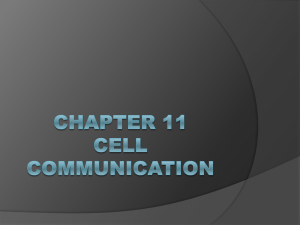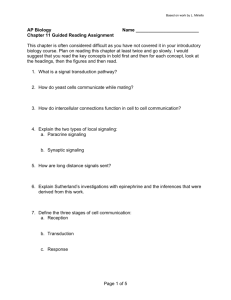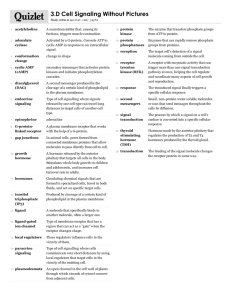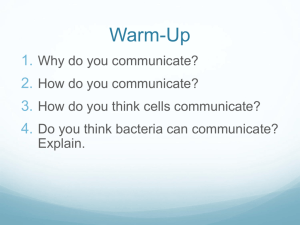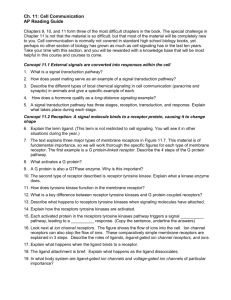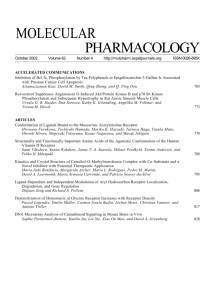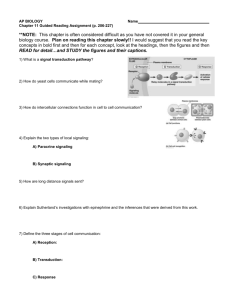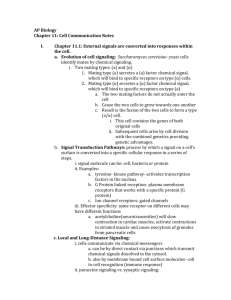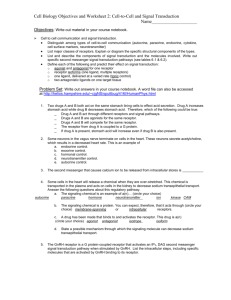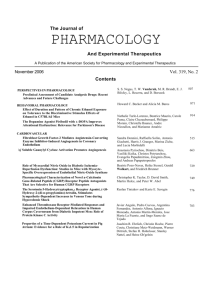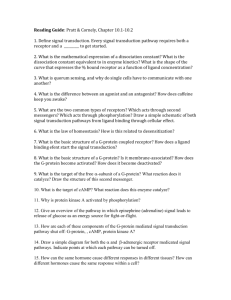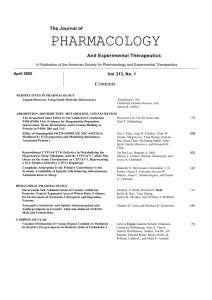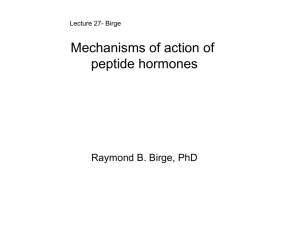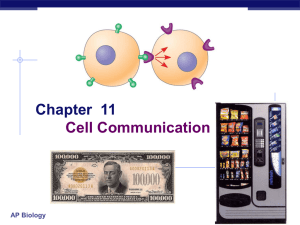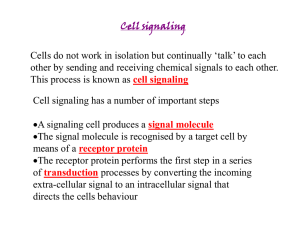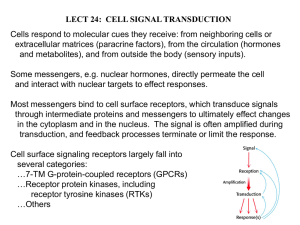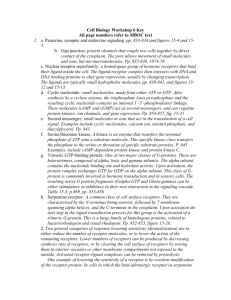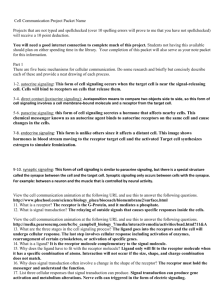G Protein-Coupled Receptor - ap
advertisement
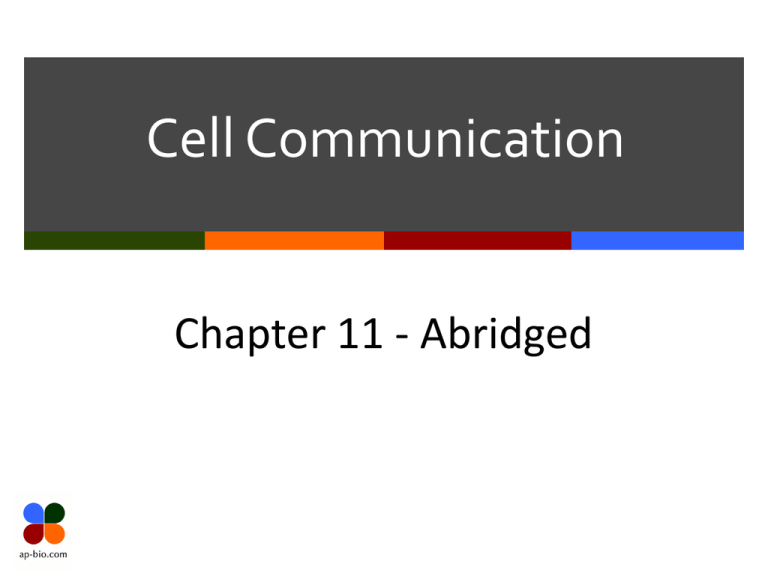
Cell Communication Chapter 11 - Abridged Cell-to-Cell Communication Critical for multicellular organisms Trillions of cells must communicate in order to coordinate their activities Recent research indicates: cancer results from corrupted communication Unimportant for the AP Exam Crucial for understanding the breakthroughs in cancer and genetics that are occurring almost monthly now Slide 2 of 23 Recent Nobel Prizes in Medicine 2001 – Hartwell, Hunt, & Nurse – cyclin pathways and cell cycle regulation (yeast) 2002 – Brenner, Sulston, Horvitz – used C. elegans to elucidate the mechanism of apoptosis 2006 – Fire & Mello - used C.elegans to discover the pathway of RNA interference Slide 3 of 23 Simon Sez… Signaling is a lot like the game “Simon Says…” The signal is received: the game players hear: “Simon says take a step forward” The signal is transduced: players must decide whether to step forward or not The signal elicits a response: players step forward if the command was preceded by “Simon says” Slide 4 of 23 3 Stages of Signaling Thesis: external signals are received & converted to responses within the cell 1. Reception Signaling molecule binds to receptor protein = Shape Change 2. Transduction Cascades of molecular interactions relay signals from receptor proteins to target molecules in the cell 3. Response Regulation of transcription or cytoplasmic activities Slide 5 of 23 1st form of signaling Yeast (fungi) mating Process: 1.Release mating factor 2.Receive complementary factor 3.???? 4.Response: grow toward opp. Type 5.Nuclei fuse = genetic recombination Slide 6 of 23 Overview of Cell Signaling Slide 7 of 23 View Animation 11_06 SignalingOverview_A.swf Slide 8 of 23 Reception Reception involves getting the signal to the correct receiver Only certain cells have the correct receptor = only certain cells can receive the signal Signaling molecule usually called ligand receptor-ligand binding causes a conformational change in the receptor molecule (remember induced fit?) Conformational change = Activation of the receptor molecule Slide 9 of 23 2 Types of Signal Receptors 1. Plasma Membrane Receptors Hydrophilic or water-soluble ligands or signal molecules G Protein-Coupled Receptors (GPCR) Receptor Tyrosine Kinase (RTK) Ion Channel Receptors 2. Intracellular Receptors Hydrophobic or Nonpolar ligands Carry out transduction by themselves Slide 10 of 23 View Animation 11_13SignalTransduction_A.swf Slide 11 of 23 G Protein-Coupled Receptor Slide 12 of 23 Receptor Tyrosine Kinase (RTK) Amplification Kinase = enzyme for transfer of phosphate group Slide 13 of 23 Ligand-Gated Ion Channel Membrane receptor with a region that acts as a “gate” when the receptor changes shape. When the signal molecule binds, gate opens or closes Important in the nervous system Slide 14 of 23 Intracellular Receptor Hydrophobic signal molecules Testosterone Most intracellular receptor signals do the entire transduction on their own Testosterone behaving as a transcription factor -- controls which genes (DNA) are transcribed into mRNA Slide 15 of 23 Transduction Multistep Pathway Transduction = shape change Signal amplification Signal Transduction Pathways often involve a phosphorylation cascade Molecule is phosphorylated = activated Phosphate removed = deactivation Slide 16 of 23 Protein Kinases (PK) -- enzymes that transfer phosphate groups Protein Phosphatases (PP) -- enzymes that remove phosphate groups Slide 17 of 23 Second Messengers 1st messenger = receptor Only GPCR & RTK have 2nd messengers Other important component of transduction pathways Most components are enzymes or proteins Small & polar Calcium Ions & Cyclic AMP Initiate a phosphorylation cascade Slide 18 of 23 Response Response may occur in the cytoplasm or nucleus 2 Types of typical response: 1. Enzyme activity is regulated (turned on or off) 2. Synthesis of enzymes is regulated (promoted or inhibited) Transcription Factors – control which genes are transcribed (DNA RNA) Slide 19 of 23 Transcription Factors Slide 20 of 23 GF = Growth factor RTK = Receptor Tyrosine Kinase Ras = G Protein Associated with tumor growth Rho = G protein Slide 21 of 23 RTK = Receptor Tyrosine Kinase GPCR – G-protein coupled receptor PDK1 = Protein dehydrogenase kinase Akt = Protein kinase -- Involved in apoptosis Apoptosis = Programmed cell death Slide 22 of 23 Day 1 Complete Slide 23 of 23
